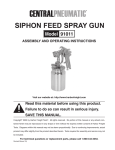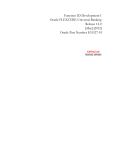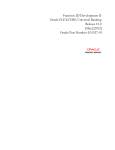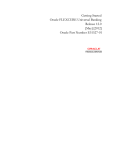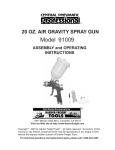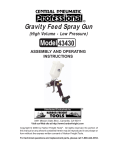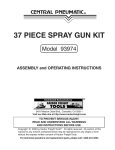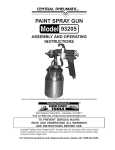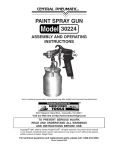Download Central Pneumatic Paint Sprayer 91011 User's Manual
Transcript
® INDUSTRIAL PAINT SPRAY GUN Model 91011 ASSEMBLY and OPERATING INSTRUCTIONS ® 3491 Mission Oaks Blvd., Camarillo, CA 93011 Visit our Web site at http://www.harborfreight.com Copyright © 2003 by Harbor Freight Tools® . All rights reserved. No portion of this manual or any artwork contained herein may be reproduced in any shape or form without the express written consent of Harbor Freight Tools. For technical questions and replacement parts, please call 1-800-444-3353 Specifications Operating and Maximum PSI Air Consumption Paint Capacity Air Inlet Nozzle Size Feed Type 20 to 50 PSI/ 80 PSI Max. 4 CFM @ 30 PSI 1 Quart 1/4” - 18 NPS .07” Siphon Save This Manual You will need the manual for the safety warnings and precautions, assembly instructions, operating and maintenance procedures, parts list and diagram. Keep your invoice with this manual. Write the invoice number on the inside of the front cover. Keep the manual and invoice in a safe and dry place for future reference. Safety Warnings and Precautions WARNING: When using tool, basic safety precautions should always be followed to reduce the risk of personal injury and damage to equipment. Read all instructions before using this tool! 1. Keep work area clean. Cluttered areas invite injuries. 2. Observe work area conditions. Do not use machines or power tools in damp or wet locations. Don’t expose to rain. Keep work area well lit. Do not use air tools in the presence of flammable gases or liquids. 3. Keep children away. Children must never be allowed in the work area. Do not let them handle machines, tools, extension cords, or air hoses. 4. Store idle equipment. When not in use, tools must be stored in a dry location to inhibit rust. Always lock up tools and keep out of reach of children. 5. Use the right tool for the job. Do not attempt to force a small tool or attachment to do the work of a larger industrial tool. There are certain applications forwhich this tool was designed. It will do the job better and more safely at the rate for which it was intended. Do not modify this tool and do not use this tool for a purpose for which it was not intended. 6. Dress properly. Do not wear loose clothing or jewelry as they can be caught in moving parts. Protective, electrically non-conductive clothes and non-skid footwear are recommended when working. Wear restrictive hair covering to contain long hair. 7. Use eye and ear protection. Always wear ANSI approved impact safety goggles. Wear an ANSI approved dust mask or respirator when working around chemical dusts, paints and mists. Wear appropriate ear protection. SKU 91011 Page 2 8. Do not overreach. Keep proper footing and balance at all times. Do not reach over or across running machines or air hoses. 9. Maintain tools with care. Keep tools clean for better and safer performance. Follow instructions for lubricating and changing accessories. Inspect tool cords and air hoses periodically and, if damaged, have them repaired by an authorized technician. The handles must be kept clean, dry, and free from oil and grease at all times. 10. Disconnect air supply. Disconnect air hose when not in use, when changing accessories, and during maintenance. 11. Remove adjusting wrenches. Check that adjusting wrenches are removed from the tool before attaching to the air source. 12. Avoid unintentional starting. Be sure the trigger is in the Off position when not in use and before attaching to the air source. Do not carry any tool with your finger on the trigger, whether it is attached to the air compressor or not. 13. Stay alert. Watch what you are doing, use common sense. Do not operate any tool when you are tired. 14. Check for damaged parts. Before using any tool, any part that appears damaged should be carefully checked to determine that it will operate properly and perform its intended function. Check for alignment and binding of moving parts; any broken parts or mounting fixtures; and any other condition that may affect proper operation. Any part that is damaged should be properly repaired or replaced by a qualified technician. Do not use the tool if any trigger does not operate properly. 15. Guard against electric shock. Prevent body contact with grounded surfaces such as pipes, radiators, ranges, and refrigerator enclosures. 16. Replacement parts and accessories. When servicing, use only identical replacement parts. Use of any other parts will void the warranty. Only use accessories intended for use with this tool. Approved accessories are available from Harbor Freight Tools. 17. Do not operate tool if under the influence of alcohol or drugs. Read warning labels if taking prescription medicine to determine if your judgement or reflexes are impaired while taking drugs. If there is any doubt, do not operate the tool. 18. Use proper size and type extension cord. If an extension cord is required, it must be of the proper size and type to supply the correct current to the compressor without heating up. Otherwise, the extension cord could melt and catch fire, or cause electrical damage to the compressor. Check your compressor’s manual for the appropriate size cord. 19. Maintenance. For your safety, maintenance should be performed regularly by a qualified technician. 20. Compressed air only. Never use combustible gas as a power source. 21. Do not spray near open flames, pilot lights, stoves, heaters, or any other heat source. Most solvents and coatings are highly flammable, particularly when sprayed. SKU 91011 Page 3 22. Clean Sprayer with care. Use non-flammable solvents. 23. Do not smoke while spraying. Most solvents and coatings are highly flammable, particularly when sprayed. 24. Read all of the information concerning coating products and cleaning solvents. Chlorinated solvents (e.g. 1-1-1 Trichlorethylene and Methylene Chloride, also known as methyl chloride) can chemically react with aluminum and may explode. Many paint sprayers contain aluminum. If you have any doubt about potential chemical reactions, contact the solvent or coating manufacturer. 25. Materials used when painting or cleaning may be harmful or fatal if inhaled or swallowed. Only use in an area with adequate ventilation. Use a respirator or mask when painting or using cleaning solvents. 26. Never release the sprayer lid while the cup is pressurized. 27. Industrial applications must follow OSHA requirements. 28. Never point a spray gun at a person or animal. Always properly mask all objects that are not to be painted. Note: Performance of the compressor (if powered by line voltage) may vary depending on variations in local line voltage. Extension cord usage may also affect tool performance. WARNING: The warnings, cautions, and instructions discussed in this instruction manual cannot cover all possible conditions and situations that may occur. It must be understood by the operator that common sense and caution are factors which cannot be built into this product, but must be supplied by the operator. WARNING: The brass components of this product contain lead, a chemical known to the State of California to cause birth defects (or other reproductive harm). (California Health & Safety code 25249.5, et seq.) Unpacking When unpacking, check to make sure the parts listed on page 8 are included. If any parts are missing or broken, please call Harbor Freight Tools at the number on the cover of this manual as soon as possible. SKU 91011 Page 4 Operation 1/4” NPS Sprayer For best service you should incorporate a regulator and inline filter, as shown in the diagram above. Hoses, couplers, regulators, and filters are all available at Harbor Freight Tools. 1. You will need to prepare a 1/4” air connector (sold separately) to connect to the air inlet on the Spray Gun. First, wrap the 1/4” air connector (not included) with pipe thread seal tape before threading it into the Air Inlet (33). Connect the 3/8” ID Air Source Hose to the Spray Gun. 2. Set the air pressure on your compressor to 20 to 50 PSI. Do not exceed the maximum air pressure of 80 PSI. 3. Check the air connection for leaks and then disconnect the tool from the air source. Spread Adjusting Valve (12) Fluid Adjusting Screw (19) Trigger (20) Air Inlet (33) Air Adjusting Screw (27) Cup (26) SKU 91011 Page 5 Operation (continued) Filling the Cup (26) Warning! The Spray Gun must be disconnected from the air source when filling or refilling material. 1. 2. Remove the Cup (26) from the Spray Gun by pressing the Lever (23) on top of the Cup (26) counterclockwise. Fill the Cup (26) with the appropriate material and turn it counterclockwise while turning the Lever (23) clockwise. See FIGURE 1. FIGURE 1 NOTE: The Lid (43) of the Cup (26) has a small vent hole in it. Before each operation, make sure the vent hole is not covered and unplugged. Do not use the Spray Gun if the vent hole is clogged. Do not turn the Spray Gun over while full or material will clog the vent hole. Note: Before spraying, mask all objects you do not want sprayed and lay cloths (not included) on the floors. Operation Note: We recommend you practice on scrap material to adjust and get to know the Gun. 1. 2. 3. 4. 5. Connect the air source hose to the Air Inlet (33). Turn on your air compressor. Do not exceed the 80 PSI maximum. Pull the Trigger (20) slowly and move the Spray Gun in parallel strokes to the object being painted. Keep the distance from the object being painted at 4” to 12”. This may slightly differ depending on the flow adjustment and the material being sprayed. Release the Trigger (20) after each forward movement; pull the Trigger (20) again on the return movement. When using a vertical pattern, move the Spray Gun in a horizontal motion; with a horizontal pattern move the Spray Gun in a vertical motion. A round pattern requires a greater distance from the object being painted. When finished, release the Trigger (20) and disconnect from the air source. The Cup (26) and Spray Gun may still hold air pressure, fire the Spray Gun toward scrap material until all of the pressure is expended. Spray Gun Adjustments Note: We recommend you practice on scrap material to learn the fine tune adjustments. 1. 2. 3. To change the spray pattern, turn the Spread Adjusting Valve (12) and/or the Air Cap Set (1). To regulate the amount of material entering the Spray Gun, adjust the Fluid Adjusting Screw (19). To fine tune the air flow, adjust the Air Adjusting Screw (27). SKU 91011 Page 6 Troubleshooting PROBLEM REMEDY CAUSE 1. Add undiluted product (check viscosity) 2. Reduce paint flow by tightening Improper spray adjustment Fluid Adjusting Screw (19) 3. Reduce air flow by turning Air Too much air flow Adjusting Screw (27) down 4. Release Trigger on back stroke Holding Trigger too long 5. Increase distance between nozzle Spraying too close and object 1. Paint too diluted Paint drips on the 2. object being painted 3. 4. 5. 4. 5. 6. 7. 1. Add undiluted product (check viscosity) 2. Increase paint flow by loosening Improper spray adjustment Fluid Adjusting Screw (19) 3. Increase air flow by loosening Air Air flow too weak Adjusting Screw (27) 4. Move Spray Gun more slowly Spray movement too fast 5. Clean components Gun clogged 6. Spray closer to object Spray distance too far 7. Adjust Nozzle Nozzle set too fine 1. 2. 3. 4. 5. Paint not thinned enough Spray Gun clogged Air Hose is broken Air Filter clogged Paint Cup not fully closed 1. Paint too diluted Paint Application uneven or irregular 2. 3. Spray Gun not operating 1. 2. 3. 4. 5. Add thinner (check viscosity) Clean components Replace Air Hose Clean or replace Air Filter Close paint cup Maintenance Disconnect from the air source. 1. 2. 3. Remove the Spray Gun Cup (26). Pour residual paint into the paint container and seal it. Pour non-flammable paint thinner into the Plastic Cup (26). If water based paint was used, you can use water. 4. Secure the Cup (26) to the appropriate Gun and shake the liquid in the cup. 5. Connect to the air source and turn on the air compressor. 6. Spray the liquid onto a piece of scrap material until the spray material is free of paint. 7. Repeat if necessary. 8. Make sure that both of the Vent Holes (top and bottom) are totally clear of paint and debris before storing the Spray Gun. Page 7 SKU 91011 Parts List Note: Certain parts cannot be ordered separately and must be ordered as part of an entire set. * (41) Air Valve Seat Set includes parts A, B, C, D, E, F, G on the diagram below. * (39) Lid Assembly Set includes part numbers 25, 31, 44, 23, 43, 34, 22, 30, 29, 42 Part No. 1 2 9 10 11 12 13 15 16 17 18 19 20 22* 21 23* Description Air Cap Set Nozzle Needle Valve Spring Copper Gasket Fluid Needle Spread Adj. Valve Set Trigger Pin 0-ring Needle Valve Guide Screw Fluid Joint Fluid Adjusting Screw Trigger 0-ring Air Orienting Ring Lever Part No. 24 25* 26 27 29* 30* 31* 32 33 34* 38* 39* 41* 42* 43* 44* Description Air Hose Joint Copper Pin Cup Air Adjusting Valve Set Baffle Nut Screw Filter Air Inlet Cup Gasket Spare Parts Lid Assy. Set Air Valve Set Material Tube Assembly Cup Top Assemby Yoke Assembly PLEASE READ THE FOLLOWING CAREFULLY THE MANUFACTURER AND/OR DISTRIBUTOR HAS PROVIDED THE PARTS DIAGRAM IN THIS MANUAL AS A REFERENCE TOOL ONLY. NEITHER THE MANUFACTURER NOR DISTRIBUTOR MAKES ANY REPRESENTATION OR WARRANTY OF ANY KIND TO THE BUYER THAT HE OR SHE IS QUALIFIED TO MAKE ANY REPAIRS TO THE PRODUCT OR THAT HE OR SHE IS QUALIFIED TO REPLACE ANY PARTS OF THE PRODUCT. IN FACT, THE MANUFACTURER AND/OR DISTRIBUTOR EXPRESSLY STATES THAT ALL REPAIRS AND PARTS REPLACEMENTS SHOULD BE UNDERTAKEN BY CERTIFIED AND LICENSED TECHNICIANS AND NOT BY THE BUYER. THE BUYER ASSUMES ALL RISK AND LIABILITY ARISING OUT OF HIS OR HER REPAIRS TO THE ORIGINAL PRODUCT OR REPLACEMENT PARTS THERETO, OR ARISING OUT OF HIS OR HER INSTALLATION OF REPLACEMENT PARTS THERETO. NOTE: Some parts are listed and shown for illustration purposes only and are not available individually as replacement parts. SKU 91011 Page 8 Assembly Drawing 39 SKU 91011 Page 9









